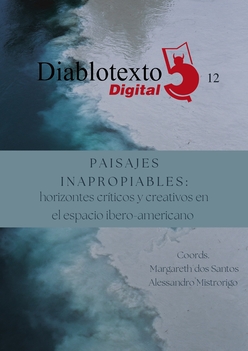Women in transition, Transition women La caída de Madrid, by Rafael Chirbes
DOI:
https://doi.org/10.7203/diablotexto.12.25063Keywords:
Rafael Chirbes, Francoism, Transition, women Abstract
Abstract
The novel La caída de Madrid (2000) takes place the day right before Francisco Franco’s death. It is this hinge-effect historical event that makes the Past, the Present and the Future converge. It is in such a chronotope that all experiences and expectations of a wide range of characters are developed. They depict the uncertainty of the Spanish society which is somewhat aware of the fact that a historical period is about to end. In this paper, the threshold of a new historical period will be analysed through two female characters that provide an interesting portrayal of that context, whose complexity can be clearly sensed on the eve of Francisco Franco’s death on 19th November in 1975.
 Downloads
Downloads
 References
References
BELVEDRESI, Rosa (2018). “Historia de las mujeres y agencia femenina: algunas consideraciones epistemológicas”, Epistemología e Historia de la Ciencia (2013), 3, 1, pp. 5-17, en https://revistas.unc.edu.ar/index.php/afjor/article/view/19865/21594 [Fecha de consulta: 1 de agosto de 2022].
CHIRBES, Rafael (2000). La caída de Madrid. Barcelona: Anagrama, Narrativas hispánicas.
GARCÍA-NIETO PARÍS, María Carmen (2000). “Trabajo y oposición popular de las mujeres durante la dictadura franquista”. En Duby, George y Perrot, Michel (Dirs.). Historia de las mujeres. Tomo 5: El siglo XX. Madrid: Taurus, Minor, pp. 722-731.
LUDMER, Josefina (1985). “Tretas del débil”. En González, Patricia y Ortega, Eliana (Eds.). La sartén por el mango. Encuentro de escritoras latinoamericanas. Río Piedras: Ediciones Huracán, pp. 47-54.
MARX, Karl [1848] (1985). El manifiesto comunista. Madrid: Sarpe.
MARX, Karl (1975). “Tesis sobre Feuerbach”. En Riestra, José Antonio y Augusto del Noce. Karl Marx. Escritos juveniles. Madrid: EMESA/Crítica filosófica.
NASH, Mary (2000). “Mujeres en España y en Hispanoamérica contemporánea. Maternidad, maternología y reforma eugénica en España, 1900-1939”. En Duby, George y Perrot, Michel (Dirs.). Historia de las mujeres. Tomo 5: El siglo XX. Madrid: Taurus, Minor, pp. 677-702.
NASH, Mary (1999). “Perfecta casada y ángel del hogar: las limitaciones de la condición femenina”. En Rojas: las mujeres republicanas en la Guerra Civil. En https://www.academia.edu/1991761/Rojas_Las_mujeres_republicanas_en_la_Guerra_Civil [Fecha de consulta: 1 de agosto de 2022].
OLEZA, Joan (2021). “En la lucha, a lo largo. El laberinto trágico de Chirbes”. En Lluch-Prats, Javier (Ed.). El universo de Rafael Chirbes. Barcelona: Anagrama, pp. 336-349. Epub.
PIERA, Julia (2011). “¿Residuales o emergentes?: una aproximación a los imaginarios de «la transición» española en cuatro mujeres de La caída de Madrid”. En López Bernasocchi, Augusta y López de Abiada, José Manuel (Eds.). La constancia de un testigo. Ensayos sobre Rafael Chirbes. Madrid: Verbum, pp. 432-447.
VELLOSO ÁLVAREZ, Javier (2021). “La otra larga marcha chirbesiana: imágenes de la condición femenina en la bildungsroman de posguerra”. En Lluch-Prats, Javier (Ed.). El universo de Rafael Chirbes. Barcelona: Anagrama, pp. 517-538. Epub.
WOOLF, Virginia [1929] (2021). Un cuarto propio. Buenos Aires: FERA.
YTURBE, Corina (2005). “El conocimiento histórico”. En Mate, Reyes (Ed.). Enciclopedia Iberoamericana de Filosofía. Tomo 5: Filosofía de la Historia. Madrid: Trotta/CSIC, pp. 207-228.
Downloads
Published
How to Cite
-
Abstract452
-
PDF (Español)349
Issue
Section
License
Licencia de reconocimiento de Creative Commons “Reconocimiento - No Comercia l- Sin Obra Derivada
Authors who publish with this journal agree to the following items:
The authors will keep their copyright and guarantee the journal the right of first publication of their work, which will be simultaneously subject to the Creative Commons license that allows third parties to share the work indicating its author and its first publication in the journal. The authors may adopt other non-exclusive license agreements to distribute the version of the published work (e.g., depositing it in an institutional telematic file or publishing it in a monographic volume), with an acknowledgment of its initial publication in this journal. The authors are allowed and encouraged to disseminate their work through the Internet (e.g., in institutional telematic archives or on their website) before and during the submission process, which can produce interesting exchanges and increase citations of the published work. (See Effect of Open Access)




